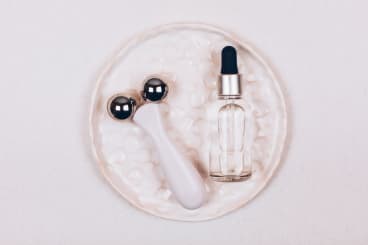 HydraFacial®
HydraFacial®In-Office vs. At-Home Microcurrent: What’s The Difference?
Looking for a skin treatment that can provide immediate and long-term lifting and firming benefits? Here’s what you need to know about microcurrent.
If the COVID-19 pandemic has meant you are spending more time tending to your own complexion (without the help of a professional) than ever before, you’re not alone. In this four-part series, The AEDITION is teaming up with Lizette Ludwig, RN, to compare some of the most popular minimally invasive in-office aesthetic treatments (microneedling, chemical peels, LED light therapy, and microcurrent) to their at-home counterparts.
Embedded content: https://youtu.be/F3dPrxEBfo8We often preach patience when it comes to enjoying the effects of in-office or at-home aesthetic treatments. But every now and then there is a unicorn service that manages to provide both immediate and long-term benefits for an array of skin types and tones. Enter the microcurrent facial, a non-invasive lifting and toning treatment that is affectionately known as the ‘non-invasive facelift.’ Here, we break down everything you need to know about in-office and at-home microcurrent facials.
What Is Microcurrent?
Electrotherapy devices were originally approved by the United States Food and Drug Administration (FDA) to treat Bell's palsy and muscle paralysis in the 1980s. But it didn't take long for the aesthetic benefits of using a nerve stimulator to send soft, gentle waves through the skin, tissues, and down to the facial muscles to reveal themselves.
One of the simplest ways to think about microcurrent is as a workout for your face. Just as you go to the gym to train the muscles of your body, microcurrent employs low-grade electrical current to contract and ‘train’ the facial muscles to appear more lifted, tightened, and firm. “Microcurrent improves facial tone, reduces puffiness, increases cellular activity, and also helps with fine lines and wrinkles,” says Lizette Ludwig, RN, an aesthetic nurse and injector in southern California. “Think of it as a natural lift for tighter, healthier skin.”
Professional Microcurrent Facials
A professional microcurrent treatment starts much like a regular facial. The skin is typically cleansed and exfoliated first. Depending on where you visit and what the facial entails, other minimally invasive treatments like LED therapy or microdermabrasion may be involved. And then comes the microcurrent. In-office microcurrent may feature gloves or handheld prongs that Ludwig says are used to “deliver precise doses of energy to the skin.”
Before the wands make contact with the skin, a water-based conductive gel will be applied to the treatment area. “It's chemically neutral, electrically conductive, and the same gel used for ultrasound or electrotherapy,” she explains. “The purpose of the conductor gel is to transmit the electric current from the device to the facial muscles.” It also helps to make the treatment comfortable and painless. “It protects the skin from zapping and enables the device to glide smoothly,” Ludwig shares. “The prongs are moved around the face and you may feel a slight tingling sensation, but it's actually relaxing.”
Microcurrent Safety & Results
As we mentioned, one of the most appealing aspects of microcurrent is how quickly you’ll enjoy the benefits. “Results can vary, but you will see them within minutes of having the treatment,” Ludwig explains. “That's the fun part — you’ll immediately feel firmer and lifted!” In fact, if your practitioner has a mirror handy during treatment, you can often see a visible lifting and de-puffing effect between the side of the face that has been treated and the side that hasn’t been.
But it’s not just a quick fix. For long-term toning, Ludwig recommends a series of 10 to 15 professional performed within six weeks. From there, your provider will put you on a maintenance schedule. Generally speaking, your eye-area will look more awake, the forehead more taught, jawline more defined, and cheekbones better contoured. Oh, and there will be an overall plumpness to the skin thanks to an increase in adenosine triphosphate (ATP) cell growth and collagen production.
Microcurrent is generally considered safe and effective for most skin types and tones. “Minor side effects can include fatigue, nausea, and sleepiness, since it is considered a detox treatment,” Ludwig explains. Microcurrent is not recommended for those who are pregnant or patients who have heart conditions. Additionally, if you have active acne breakouts, it might be best to wait until they heal to seek treatment.
At-Home Microcurrent Devices
Chances are you’ve seen a host of at-home microcurrent devices (we’re fans of the NuFace Trinity Facial Toning Device and ZIIP Nanocurrent Device) that promise similar results to their in-office counterparts. These tools can be quite effective, but, as with most consumer models, “at-home devices aren’t as powerful as professional-grade devices,” Ludwig notes.
Consistency is the key to reaping the benefits of microcurrent at home. “With microcurrent therapy, it's all about completing treatments as recommended,” she explains. In the case of at-home devices, frequent use is possible (and necessary!), so it’s important to follow the instructions provided by the manufacturer. When in doubt, consult with your dermatologist.
“Results are often immediate, but, for long term results, accumulative treatments are required,” Ludwig concludes. “Like all preventative skin treatments, they do not stop the aging process. Instead, think of it as slowing down the aging process.”
All products featured are independently selected by our editors, however, AEDIT may receive a commission on items purchased through our links.
More Related Articles
Related Procedures

AI Plastic Surgeon™
powered by'Try on' aesthetic procedures and instantly visualize possible results with The AI Plastic Surgeon, our patented 3D aesthetic simulator.


